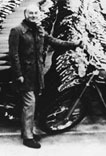 Edison Dye is considered by many to be the father of motocross in the United States. In the late 1960s, Dye brought over many of Europe’s top motocross stars to race against the scrambles racers of America. It was no contest. The European riders dominated. The Europeans, who had been racing motocross since just after World War II, were clearly superior in the riding techniques and training methods.
Edison Dye is considered by many to be the father of motocross in the United States. In the late 1960s, Dye brought over many of Europe’s top motocross stars to race against the scrambles racers of America. It was no contest. The European riders dominated. The Europeans, who had been racing motocross since just after World War II, were clearly superior in the riding techniques and training methods.
But instead of discouraging the American riders, seeing the experience inspired the first generation of motocross riders in America. This led to the explosion of the sport in the United States during the 1970s. Motocross, and its later offshoot, Supercross, would become the most popular form of motorcycling competition in America, and U.S. riders would become some of the best in the world. Dye foresaw that explosion and was a major catalyst in bringing motocross to this country.
Mario Edison Dye was born in Oskaloosa, Iowa, on May 10, 1918. His father was a photographer and later a schoolteacher and his mother a telephone operator. When Dye was a boy, he and his mother moved to Southern California. Dye graduated from Hoover High School in San Diego and enrolled at San Diego State University in 1937 to study Aeronautical Engineering. While in college Dye became interested in hot rod racing and participated in speed contests held on various dry lakebeds in Southern California.
During World War II, Dye worked for Gulberson Diesel Engine, designing waterproof manifolds for tanks to enable them to keep running under water. Later he would design and build front turrets for B-24 bombers. He was in charge of 7,500 employees at the war's end.
After the war, Dye moved back to San Diego and ran a trucking business. In 1960, he decided to take some time and tour Europe. He did so by opening a motorcycle touring business. He operated tours to the Isle of Man TT races and later expanded to operate tours all across Europe.
His European travels exposed him to the popular sport of motocross. Always eager for new opportunities, Dye called and made an appointment to meet with Husqvarna officials about selling motocross bikes in the United States. He took a couple of bikes to the United States and asked Malcolm Smith to try one out. Smith told him he rode Greeves motorcycles, but agreed to ride the Husky to give Dye his opinion of the bike.
"We went up in the hills," recalls Dye. "Malcolm was gone a long time and when he came back he had a funny little smile on his face. He told me it was a great bike and that he’d like to try it out in a desert race that weekend. He went out won that race by over 22 minutes. After that, Malcolm became one of my best riders. He rode for me for six years and I consider him the best long-distance rider in the world."
At first, Dye sold the Husqvarna race bikes to select riders. By the mid-1960s, however, he was rapidly becoming a bona fide importer. The first year he sold 100, then 500 the next, then 1,000 by the third year.
Dye was traveling to the world championship motocross races in Europe with Torsten Hallman. Dye came up with the idea to bring the top riders to America to race after the Grand Prix season was over. In 1966, he flew Hallman over for a series of U.S. races. Hallman won every moto he entered. The following year, Dye brought over Hallman again, along with other top riders such as Joel Robert, Roger DeCoster, Dave Bickers, Arne King and Ake Johnson. For the next several years, Dye continued to bring the best European stars to America to race, which led to Dye forming the influential Inter-Am motocross series. Motocross racing in America was well on its way to its boom years of the 1970s.
In an effort to bring even more notoriety to Husqvarna, Dye brought over world championship motocross star Lars Larsson from Sweden to demonstrate the capabilities of the bike. Despite barely speaking any English, Lars signed up dealerships and raced at tracks all across America, helping to bring great recognition to Husqvarna.
Dye called DeCoster his favorite of all the riders.
"He rode with so much style and was so spectacular to watch over the jumps," Dye says.
During the late 1960s, Dye also founded a motocross accessory business to provide motocross riders with imported racing gear that provided better protection than what was generally available in the United States at that time. His supplier was a company in Sweden that produced hockey gear. It turned out that much of the protection worn by hockey players was perfectly suited for the needs of motocross racers, as well.
Dye continued with his motocross import business until he retired in the 1980s.
"I had spent the biggest part of my life racing on the weekends, selling bikes during the week. I was ready for some rest," he says.
Dye’s style and personality seemed a bit out of place in the cow pastures of America with his custom-tailored jackets, often accompanied by impeccably dressed and beautiful women and his trademark stroker cap. Dye was often described as eccentric. He was certainly unconventional.
Dye will go down in history as one of the most influential figures in U.S. motocross. In the process of trying to sell more Husqvarnas, Dye brought motocross racing to the United States.
Dye passed away on May 10, 2007, his 89th birthday.